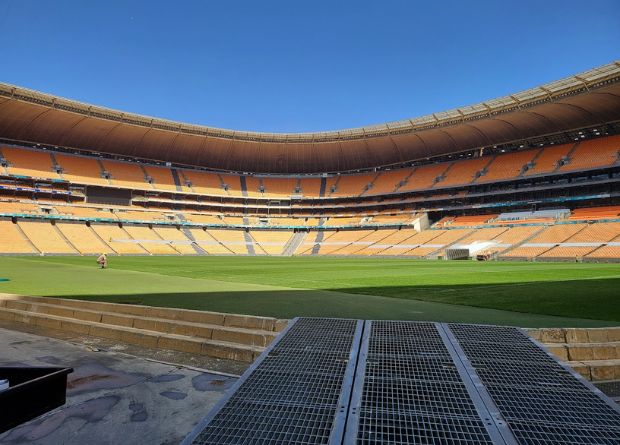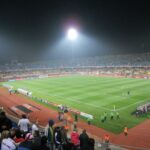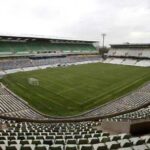FNB Stadium, also known as Soccer City, is a world-renowned stadium located in Johannesburg, South Africa. It is one of the largest stadiums on the African continent and has a seating capacity of 78,000 spectators. The stadium has hosted numerous high-profile events, including the 2010 FIFA World Cup, and has become an iconic landmark in the city.
Construction of the stadium began in 1986 and was completed in 1989. The stadium underwent a major renovation in 2009 in preparation for the 2010 World Cup. The renovation included the addition of a new roof, improved seating, and upgraded facilities. The stadium’s unique design is inspired by the African calabash, a traditional African cooking pot, and features a distinctive shape that is instantly recognizable.
In this article, we will take a closer look at the construction features of FNB Stadium and explore the unique design elements that make it such an iconic landmark. We will delve into the stadium’s history, the materials used in its construction, and the challenges faced by the builders during its construction. Join us on this journey as we explore the inner workings of one of the world’s most famous stadiums.
Historical Overview of FNB Stadium
FNB Stadium, also known as Soccer City, is a stadium located in Johannesburg, South Africa. The stadium was built between 1986 and 1989 with a capacity of approximately 80,000 spectators. It was designed by Boogertman + Partners Architects and was initially used for rugby matches.
In 1990, the stadium was renamed as the National Stadium and was used for various sporting events, including soccer, rugby, and cricket. In 2003, the stadium underwent major renovations, which included the addition of a second tier to the western stand, increasing the stadium’s capacity to 94,700 seats.
The stadium was chosen as the main venue for the 2010 FIFA World Cup and underwent further renovations to meet FIFA’s standards. It became the largest stadium in Africa, with a seating capacity of 84,490 during the World Cup due to reserved seating for the press and VIPs.
Today, FNB Stadium is the home stadium of the Kaizer Chiefs football club, and it is also used for other events, including concerts and political rallies. In 2013, the stadium hosted the memorial service for Nelson Mandela, who had a personal connection to the stadium as he made his first speech in Johannesburg after his release from prison in 1990.
Overall, FNB Stadium has a rich history and has played a significant role in South African sports and politics. It continues to be a prominent landmark in Johannesburg and an important venue for various events.
Architectural Design and Structure For FNB Stadium

The FNB Stadium, also known as Soccer City, was designed by Boogertman Urban Edge & Partners and was built in 1987. It was reconstructed between 2006 and 2009 for the 2010 FIFA World Cup. The stadium has a unique design inspired by an African pot, with a facade made of a mosaic of fire and earthen colors.
Stadium Layout and Capacity
The stadium has a seating capacity of 94,736, making it the largest stadium in Africa. The seating arrangement is divided into two tiers with a ring of lights running around the bottom of the structure, simulating fire underneath the pot. The lower tier has a seating capacity of 37,500, while the upper tier can seat 57,236 spectators.
The stadium has a rectangular shape with a length of 290 meters and a width of 265 meters. It has a total area of 87,000 square meters, and its highest point is 60 meters above the pitch. The pitch itself is 105 meters long and 68 meters wide.
Roof and Facade Engineering
The stadium’s roof is supported by 12 40-meter-high concrete shafts and 16 circular columns, each 1 meter in diameter. The roof is made of a membrane that covers an area of 37,000 square meters. The membrane is supported by a cable net system that spans the length and width of the stadium. The roof is designed to protect spectators from the sun and rain while allowing natural light to enter the stadium.
The facade of the stadium is made of a mosaic of fire and earthen colors that reflect the African culture. The facade is designed to withstand the harsh weather conditions of Johannesburg, including high winds and heavy rain. The stadium’s facade also features a ring of lights that run around the bottom of the structure, simulating fire underneath the pot.
In conclusion, the FNB Stadium’s unique design and engineering make it one of the most iconic stadiums in the world. Its capacity, roof, and facade engineering make it an excellent venue for hosting international events such as the 2010 FIFA World Cup.
FNB Stadium Construction Process

Materials and Foundations
The construction of FNB Stadium (Soccer City) was completed in 2010, just in time to host the FIFA World Cup. The stadium has a unique design that resembles an African pot. The outer layer of the stadium is made of a mosaic of fire and earthy colors, while the bottom of the structure features a ring of lights, simulating fire underneath the pot.
To ensure a stable foundation, the stadium was built on a reinforced concrete raft foundation, which spreads the weight of the structure evenly across the ground. The foundation was designed to withstand the weight of the stadium and the dynamic loads from the spectators and the players during the games.
The materials used in the construction of the stadium were carefully chosen to ensure durability and longevity. The structural frame of the stadium is made of reinforced concrete, while the roof structure is made of steel. The seating areas are made of precast concrete panels, which were assembled on-site.
Innovative Building Techniques
The construction of FNB Stadium (Soccer City) used innovative building techniques to ensure that the stadium was completed on time and within budget. One of the most notable techniques used was the use of precast concrete panels for the seating areas.
The precast panels were manufactured off-site and transported to the construction site, where they were assembled into the seating areas. This technique allowed for faster construction times and reduced the amount of on-site labor required.
Another innovative technique used was the use of steel for the roof structure. The steel roof was designed to be lightweight and easy to assemble, which reduced the time and labor required for construction.
Overall, the construction process for FNB Stadium (Soccer City) was carefully planned and executed to ensure that the stadium was completed on time and within budget. The use of innovative building techniques and carefully chosen materials ensured that the stadium is a durable and long-lasting structure.
Also, check: Royal Bafokeng Sports Palace Construction and Sitting Plan: An Inside Look
Sustainability and Modern Features
Energy Efficiency
Inside FNB Stadium, there are various energy-efficient features that help to reduce energy consumption. The stadium has energy-efficient lighting, which includes LED lights. These lights use less energy than traditional bulbs and have a longer lifespan. The stadium also has a building management system that controls the lighting and HVAC systems. This system ensures that the lights and HVAC systems are only used when needed, reducing energy waste.
Water Conservation
The stadium has implemented several water conservation measures to reduce water consumption. One of the measures is the use of rainwater harvesting. The stadium’s roof collects rainwater, which is then stored in a tank and used for irrigation and flushing toilets. The stadium also has low-flow toilets and urinals, which use less water than traditional fixtures. Additionally, the stadium has installed faucets with sensors that turn off automatically when not in use, reducing water waste.
Overall, the FNB Stadium is a modern and sustainable facility that incorporates energy-efficient and water conservation features. These features help to reduce the stadium’s environmental impact and contribute to a more sustainable future.



